I
nnovation is, and always will be, at the center of a thriving textile industry. It is the
secret – the primary attribute missed in a quick analysis by an industry outsider. Textiles as a
major process manufacturing industry has evolved by inventing and adopting technology for as long
as fiber has been spun into yarn. On the heels of a year punctuated by major technology
exhibitions, ITMA and ShanghaiTex among them, what better way to celebrate the best the textile
industry has to offer than by looking at recent developments in textile technology available from
around the globe.
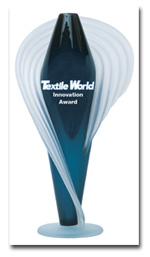
Textile World
‘s Innovation Award is better known for recognizing a textile manufacturer that has
demonstrated commitment to research and selective investment in applied technology – a company
meeting challenges beyond product and process invention. Consider the track record of past
honorees, including Springs Industries, Avondale Mills, Milliken & Company, Johnston
Industries, Parkdale, Swift Denim, and Mount Vernon Mills – could they prosper in today’s global
marketplace without the innovative machinery and technologies that drive productivity, enable
product development and add flexibility to the manufacturer’s mix?
One of the most direct effects of innovation in industry is the sense of competition it
brings – not just in ideas, but also in the form of real products. This competition, coupled with
capital investments by the manufacturers, keeps the momentum of a volatile industry moving forward.
ITMA 2003 proved that machinery suppliers are working diligently to provide faster, more
reliable and more technologically advanced machinery. The exhibition, better attended than anyone
had expected, illustrated the importance of technology in the industry and the interest of textile
manufacturers around the world in investing in the future.
During the past year, textile manufacturing in North America has had its challenges. Today,
the textile landscape is evermore dependent on innovation and change. A piece of technology that
can add a product, enhance an end-use, cut a cost, add flexibility, or help enter a market not only
is welcome, but often makes the difference between a manufacturer’s success and failure.
The companies honored this year have risen to the challenge. The
Textile World
2004 Innovation Awards recognize industry leaders that have developed and are producing
technologies that make a difference in plants around the world. The list goes on, but the companies
on the next several pages have the track record, the industry acceptance and sometimes just the
shear tenacity to strive to advance textiles into the future and beyond.
Dual System For Rapidstretch And Technodye Machines
Argelich, Termes Y Cia S.A. (ATYC), Spain
ATYC’s Dual System enables a single machine to provide high circulation speeds for man-made
fibers and softer treatment for natural fibers such as cotton and wool. The Dual System’s double
nozzle consists of a soft nozzle designed to process articles sensitive to felting, pilling and
abrasion; and a hard nozzle for articles that are less sensitive and require higher circulation
speeds. The injector type, flow and working pressure are selected from the machine’s control system
for optimal treatment of the fabric to be processed.
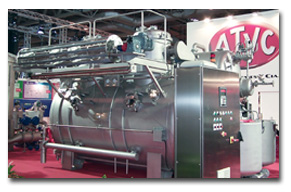
ATYC’s Dual System for its Technodye (above) and Rapidstretch machines features a hard and
soft dual nozzle.
Spyra 6 Compact
Biancalani S.p.A., Italy
Biancalani’s Spyra 6 Compact is the newest member of the Spyra family. Designed for small-
to medium-sized textile manufacturers, as well as companies involved in mass production, the Spyra
6 Compact dries, softens and compacts woven, nonwoven or knitted fabrics in rope form. The
six-tumbler machine features rotating or oscillating baskets that perform the softening and
compacting action. The goods are delivered into the entry, where air jets convey them to the back
of a tumbling chamber that oscillates from side to side. The machine’s most interesting feature is
that the continuous tumbling action compacts the fabric without introducing knots and tangles
associated with traditional batch tumbling dryers. According to the company, the machine is
versatile and can be used with continuous and discontinuous treatments, as well as in fragmented
production cycles.
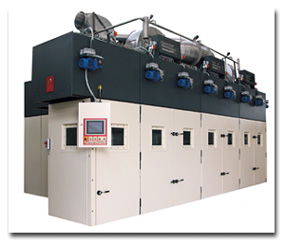
The Spyra 6 Compact from Biancalani uses tumbling action to dry, soften and compact fabric
without introducing knots or tangles.
Innodye®
Brazzoli S.p.A., Italy
The Innodye® jet-dyeing machine from Brazzoli incorporates a variable-speed mobile basket
that moves transversely to the direction of fabric advancement as the fabric moves through the
Turbovario, a variable conical cross-section nozzle. The motion of the J-shaped basket plaits the
fabric rope as it moves from the top of the machine into the immersion area. The basket’s movement
also permits rapid and uniform mixing of the dyes and chemicals with reduced foam formation.
A new double-injection dosing system allows natural or man-made fabric to be dyed in rope
form with quick introduction of all chemicals for uniform results. The machine also is suitable for
scouring, bleaching and washing fabrics. Each port offers a 440-pound nominal loading capacity.
According to Brazzoli, the machine offers time savings, as well as lower water and energy
consumption.
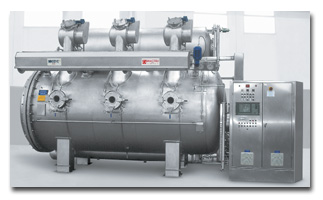
Innodye® was designed to optimize and strengthen the hydrodynamics of the movement of the
bath and fabric in relation to the velocity of the chemical reactions.
Flatbed Laminating Line
For Powder Adhesives
Glenro Inc., Paterson, N.J.
Dry adhesives are considered more user friendly because they do not produce smoke when
heated, unlike some other adhesive types. Glenro’s new flatbed laminating line was developed for
use with powder adhesives. The laminator’s coater evenly applies controlled amounts of dry powder
adhesives to the bottom foam ply. The adhesive then is partially melted into the foam using an
infrared oven to reduce powder shift as the material moves through the laminator. In a matter of
seconds, a continuous plane of heat in conjunction with adjustable pressure bonds the material
while eliminating insulating air gaps, for a uniform bond.
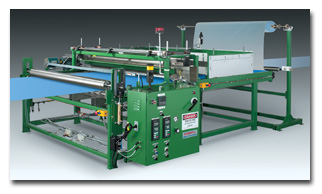
Glenro’s flatbed laminating machine for powder adhesives uniformly bonds material without
air gaps.
DNB/EL-800
Comez S.p.A., Italy
Comez’s DNB/EL-800 double-needle-bed crochet machine features two needle beds and
electronically driven weft bars for the production of double-faced fabrics. Each side of the fabric
appears identical to the other, and the structure has good 3-D consistency, according to the
company. The machine can process any type of yarn, and, with an 800-millimeter working width, can
produce a variety of fabrics for apparel end-uses such as scarves and shawls, as well as netting,
and technical and medical fabrics.
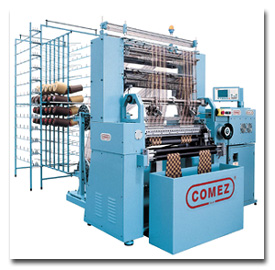
Fabrics made using Comez’s DNB/EL-800 are suitable for apparel applications, as well as
more technical end-uses such as medical fabrics.
Carpet Star®
Fehrer AG, Austria
The high-speed Carpet Star® structuring needlepunching machine produces needled carpets
using two needle zones that operate independently. Each zone is controlled electronically, so that
a combination of rib and velour structures can be created in a single pass. Large repeat patterns
are possible, as are surrounds or borders on all sides. Border and body patterns may differ, and
carpets that resemble Oriental carpets can be produced. According to Fehrer, Carpet Star creates a
high-quality finished product in which joins between patterns are not noticeable.
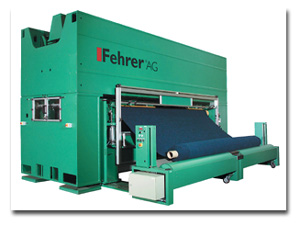
Fehrer’s Carpet Star® offers high-speed, maximum pattern design flexibility.
Dornier EasyLeno®
Lindauer Dornier GmbH, Germany
Dornier’s EasyLeno®, available on both air-jet and rapier weaving machines, is suitable for
all leno fabrics, from very light curtain fabrics to very heavy glass roving fabrics. The company’s
new system permits leno fabrics to be woven at much higher speeds. According to the company,
production speed is not limited by EasyLeno, but rather by other machine functions. The system
varies from a typical leno device because it uses two needle bars operated by the existing loom
drive. The system exhibits minimum warp end needle wrap for gentle treatment of the warp ends, and
low needle wear.
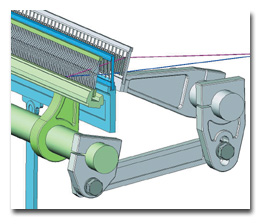
EasyLeno® schematic
AquaJet Spunlace Systems
Fleissner GmbH, Germany
Fleissner has developed a process using its AquaJet™ Spunlace System to significantly
improve the surface structure of hydroentangled webs. High demands are placed on the surface
quality of a hydroentangled web, especially when used in man-made leather coating applications.
According to Fleissner, the new process eliminates the formation of straight lines on the surface,
within the surface and within the web by the water jets. The highly uniform surface structure also
enables even, level dyeing of the fabric.
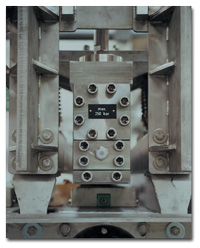
Oscillating jet manifold of Fleissner’s AquaJet™ Spunlace System
Allwin High-Temperature
Package-Dyeing Machine
Fong’s National Engineering
Co. Ltd., Hong Kong
Fong’s has made this package dyer more heat- and energy-efficient with the addition of an
innovative pump design, coupled with a two-pass design of the heat exchanger. According to the
company, the pump’s concentric pump discharge and suction opening allows it to deliver higher flow
rates than traditional pumps under the same level of pressure head. The heat exchanger’s two-pass
design reduces heat loss, which improves energy efficiency.
The design of the coupling pipe network is much simplified, which also reduces energy
consumption. In addition, the new pipe network allows the machine to run as two single machines or
as one large batch machine. The company has applied fuzzy logic control to the temperature control
system for more accurate control. The machine offers liquor ratios as low as 1:4 and space savings
of up to 30 percent compared to similar conventional machines, according to Fong’s.
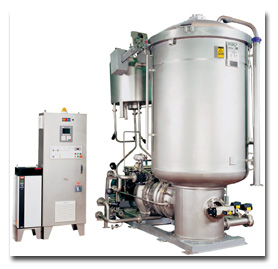
Fong’s Allwin high-temperature package-dyeing machine features heat- and energy-efficient
attributes.
Quick Change FluiDyer QCC
Eduard Küsters Maschinenfabrik
GmbH & Co. KG, Germany
When the Quick Change FluiDyer QCC is in injection mode, the carpet tuft is uniformly dyed
from top to bottom. The overflow mode allows expanded styling capabilities. The QCC can change from
one color to the next in just one second, thus reducing by a ratio of 10:1 the amount of carpet
normally wasted during a color change. The machine also enables carpet manufacturers to run to
order, saving on inventory costs.
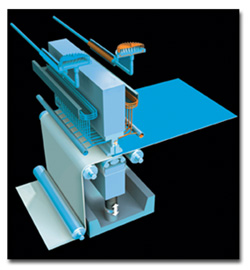
Küsters’ Quick Change FluiDyer QCC is the first carpet-dyeing machine that enables both
injection and overflow applications on the same machine.
UltraScan® PRO
HunterLab, Reston, Va.
The UltraScan® PRO is the first color measurement spectrophotometer to calibrate and control
the light source in both the ultraviolet (UV) and visible regions of the spectrum. The technology
enables it to achieve a CIE AB rating for D65 illumination for accurately measuring fluorescing
agents that excite in the UV region (such as materials containing optical brighteners) and those
that excite in the visible region (such as bright fluorescent colors). In addition, the
spectrophotometer has an extended measurement range that permits measurement not only of visible
color, but also measurement into the near-infrared range for camouflage materials.
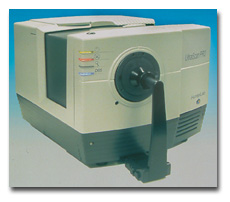
HunterLab’s UltraScan® PRO calibrates and controls the light source in both the UV and
visible regions of the spectrum.
YarnMaster & MillMaster
Loepfe Brothers Ltd., Switzerland
The YarnMaster digital on-line quality control system from Loepfe monitors yarn during the
winding process. Using an exclusive clearing parameter, the Loepfe Surface-Index (SFI/D),
YarnMaster can be used to detect and remove yarn faults including foreign matter and off-quality
yarn with respect to hairiness, unevenness and other imperfections. Each YarnMaster system can be
connected to Loepfe’s MillMaster central management system, which monitors and documents production
data on-line for 100 percent of the yarn produced. If off-standard quality values are detected, an
alarm is raised. Used together, MillMaster and YarnMaster can reduce the number of standard
sampling tests and off-line quality tests required in a laboratory.
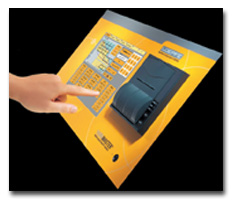
Loepfe’s YarnMaster system is a digital, on-line method of monitoring yarn quality during
production.
Contax®
Leatex Corp., Philadelphia
Leatex Corp.’s collaboration with Sauquoit Industries resulted in Contax®, a revolutionary
new product for static control. Based on hyperconductive materials, Contax is a more efficient and
more versatile, yet cost-effective replacement for traditional static control products.
The product reduces static on most substrates and can be used readily on most textile
equipment and processes including drying, beaming and cutting. It is simple to use because it
requires no electricity source and generates no effluent. Increases in productivity and product
quality through increased line speeds, and reduced machine jams and reprocessing provide a quick
return on investment.
In addition, employees’ safety and comfort are greatly increased because extreme
electrostatic shocks common in textile manufacturing are eliminated.

MULTIFLOW® Paggi Patent
& MCS Patent Mod.SUPERIOR
MCS, Italy
Featuring single-rope technology, MCS’ MULTIFLOW® Mod.SUPERIOR boasts uniform, repeatable
reactive dyeing times of less than four hours. The use of a single rope allows the fabric to be
moved from one dyeing channel into the next. Because all fabric passes through all channels, no one
channel is favored or disadvantaged during dyeing. This factor reduces dwell times because it’s no
longer necessary to wait for all channels to reach the desired shade. By using a stepping motor,
the MULTIFLOW is the first machine on the market to change jet pressure on its hydrovario jet
nozzle without changing the nozzle’s diameter. The machine is capable of processing knitted and
woven fabrics including terry towels and upholstery fabrics.
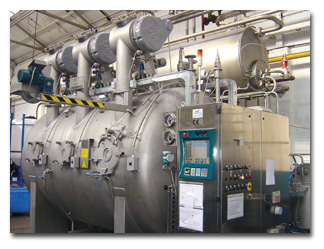
MCS’ MULTIFLOW® Paggi Patent & MCS Patent Mod.SUPERIOR can complete a reactive dyeing
process in less than four hours.
Econtrol™ Knit Process
For Monforts’ Thermex 6500 Hotflue
A. Monforts Textilmaschinen GmbH & Co. KG
This new technology makes it possible to dye knitted fabrics in a continuous rather than a
discontinuous process in record time. According to Monforts, dyeing times of 12 to 24 hours have
been reduced to just two minutes. Econtrol™ Knit was developed in cooperation with Germany-based
DyStar specifically for Monforts’ new Thermex 6500 dryer. The process uses reactive dyestuffs with
no salt or urea and, according to Monforts, achieves 5- to 8-percent higher dyestuff yields than
other processes. Results are reproducible and variation-free. Using Econtrol Knit, it is possible
to dye cotton/elastane blends without sewing the fabric into tubular form. The Thermex 6500 is a
loop dryer featuring Exxotherm indirect gas heating. The machine handles fabric capacities of up to
51 meters. Econtrol is a DyStar trademark, and the machine technology is available exclusively from
Monforts.
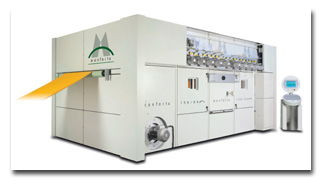
Monforts’ Thermex 6500 Hotflue dryer uses DyStar’s Econtrol™ Knit process to provide quick,
reproducible dyeings on knitted fabrics, achieving high dye yields and reduced production costs.
Müller MDL/C Direct Digital Weaving System
Jakob Müller AG, Germany
Jacquard weaving technology was developed some 203 years ago. It’s taken a little while to
improve the technology, but Müller recently introduced a jacquard machine that revolutionizes
jacquard weaving for narrow fabrics. The development of Müller’s MDL/C with direct thread guidance
now makes it possible to create soft-edged, multicolored jacquard narrow fabrics without using
harnesses, comber boards, retracting springs, dobby machine or treadling devices. Since it has no
harnesses, the machine offers free access to all threads and allows up to 111 warp threads per
centimeter. Warp thread tension setting and control are fully electronic, and the machine features
a touch-screen monitor with open controller area network (CAN) Bus.
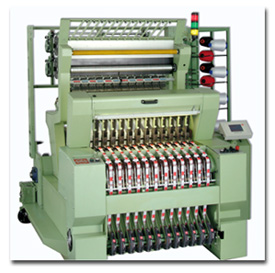
Müller’s MDL/C direct digital weaving system has removed many of the jacquard parts for
more simple operation and maintenance.
Murata Vortex Spinner (MVS) No. 861
Murata Machinery Ltd., Japan
The latest-generation Murata Vortex Spinner (MVS), No. 861, features an increased spinning
speed of up to 450 meters per minute. Tension Ruler, a new tension control system, in combination
with the MSC yarn clearer and VOS visual monitoring system, makes it possible to wind a 5 degree 57
package limitation-free. The machine produces 100-percent cotton yarns, as well as man-made yarns
and yarn blends, in counts ranging from 12/1 to 70/1. Murata claims the yarn is similar in quality
to ring-spun yarn having excellent hand, as well as outstanding non-pilling, non-linting, wicking
and wash-and-wear characteristics. A new attachment for MVS No. 861 is available for elastomeric
core/filament yarns. An attachment for adding color during the spinning process also is available.
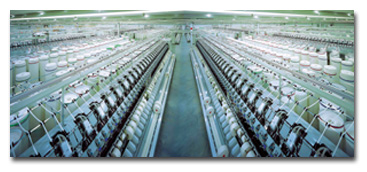
Murata’s Vortex Spinner No. 861 is a unique yarn spinning system that takes sliver to
finished cones/tubes. The machine recently was updated to run at 450 meters per minute.
Micro-Sat
Morrison Textile Machinery Co.,
Fort Lawn, S.C.
Morrison’s Micro-Sat for high chemical pickup applications features a horizontal three-roll
nip assembly, which consists of a rubber-covered squeeze roll, a stainless steel center roll and a
urethane-covered micro-adjustable gap roll. The clever arrangement of these rolls provides a
positive nip to ensure uniform liquor penetration — even on tight selvages — followed by a
micro-gap-controlled exit nip for high chemical pickup. According to Morrison, chemical pickup of
up to 140 percent has been measured on the Micro-Sat.
Driven rollers match the overall process speed, prevent the fabric from wrinkling during
processing and avoid wiping of the fabric.
A magmeter ensures all chemicals flow as required within the system. A level control
following the magmeter maintains a constant chemical level in the saturator during operation.
The volume of chemical in the Micro-Sat is low, resulting in high chemistry turnover, so the
bath’s concentration does not require periodic titration as with conventional saturators.
In addition to uses in scouring and bleaching applications, the Micro-Sat can be used as a
finishing applicator in various fabric finishing operations.
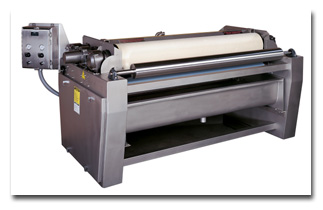
The Micro-Sat from Morrison Textile Machinery enables chemical pickup of up to 140 percent
in scouring, bleaching and other finishing operations.
OPF Engineered Feeding Unit
Orizio Paolo S.p.A., Italy
Orizio Paolo’s OPF engineered feeding unit for knitting machines monitors excessive yarn
tension and can adjust the feed rate to avoid broken threads. Should a thread break, the machine
stops automatically and the affected regulator reports the fault, which is registered by the motor.
All information is stored and is available for later statistical evaluation. Each of the patented
feeder heads has its own motor drive, with rotation speed set and controlled by a central computer.
This new arrangement makes quality wheels and drive belts for the regulators a thing of the past,
according to the company.
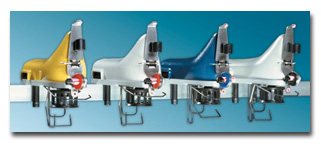
Orizio Paolo’s OPF engineered feeding unit stops the knitting machine automatically if a
thread break is detected.
C 60 Card
Rieter Machine Works Ltd., Switzerland
Rieter’s C 60 high-performance card produces output at speeds of up to 180 kilograms per
hour. Its 1,500-millimeter working width is unique in the market. According to Rieter, the card can
process all types of materials at production rates up to 50-percent higher than previous models
without compromising sliver quality. A new optimized suction system along with the high centrifugal
forces generated by the C 60 result in a reduced trash and dust content in the finished sliver. For
open-end spinning applications, the C 60 may be integrated with Rieter’s non-leveling SB model
drafting system or its RSB autoleveler drafting system.
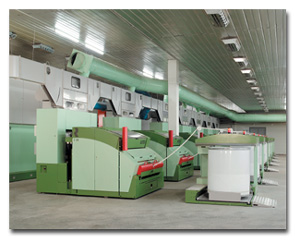
Rieter’s C 60 card has a working width of 1,500 millimeters.
SM8-TOP2
Santoni S.p.A., Italy
The name Santoni has become synonymous with seamless knitwear. The company is focused on
building machines that can manufacture ready-to-wear garments. The SM8-TOP2 exemplifies this focus.
It is an eight-feed, single-jersey circular knitting machine for underwear, outerwear, swimwear,
sportswear and sanitary knitted garments. Cylinder diameters range from 12 to 17 inches; with
machine gauges of 16, 22, 24, 26, 28 and 32 needles per inch. The SM8-TOP2 runs at a speed factor
of 1,430, which translates to a maximum speed of 110 revolutions per minute for a 13-inch-diameter
cylinder.
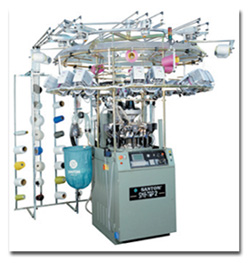
Santoni’s SM8-TOP2 machine can be used to produce a variety of seamless apparel.
Athena™ With Wisdom
Sclavos International S.A., Greece
The Athenà™ with Wisdom optimizes process parameters by constantly monitoring and adjusting
settings during the dyeing process for any shade and any batch loading size – from 60 kilograms
(kg) up to 1,500 kg. Such features as Wisdom AquaChron rinsing, continuous flow dosing, a dry salt
system and Sclavos heat recovery reduce water, steam, electricity, dyes, chemicals and labor.
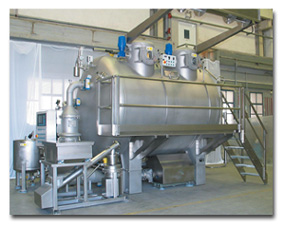
Sclavos’ Athenà™ with Wisdom features process “intelligence” — a high level of automation
for high quality and lowest operating costs.
Common Platform
For SMIT Weaving Machines
SMIT S.p.A., Italy
In order to standardize its production process and create high production volumes, SMIT has
developed a common platform for its diversified series of weaving machines. This platform includes
a versatile collection of castings and mechanical and electronic parts that can be utilized during
manufacturing to construct one of a number of different machines. Using this platform, the company
claims, its GS900 and JS900 machines offer great technological advantages at an economical price.
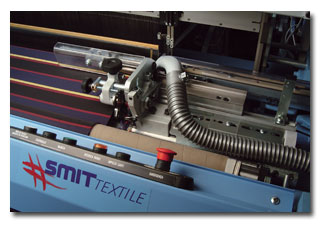
SMIT’s common platform allows the company to produce a diversified but standardized series
of machinery with a high level of productivity.
Spinnbau DeltaCard
Spinnbau GmbH, Germany,
A Member of the Dilo System Group
The high throughput of the Spinnbau DeltaCard makes it suitable for thermobonding and
hydroentanglement processes.
The machine has three main features: First, the Delta Transfer System features a triangular
arrangement of the transfer rolls (hence the name Delta), adjustable transfer ratio and high
throughput speeds. Second, the patent-pending Sigma Doffing System, designed using a perforated
roll surface in conjunction with a negative pressure system, offers multi-web doffing of up to four
doffers. Web design from carding is preserved because there is a draftless transfer of individual
webs to the transport conveyor along with the multi-web doffing. Third, Spinnbau’s random roll
technology allows determined fiber reorientation.
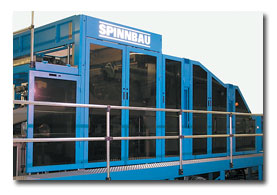
The DeltaCard from Dilo System Group member Spinnbau takes its name from the fact that its
transfer rolls are arranged in a triangular pattern in the Delta Transfer System.
Alpha Rapier Loom
Promatech S.p.A., Italy
Promatech’s Alpha rapier loom is the first product to come out of Promatech’s R&D
center, which builds upon 30 years of experience from both Somet and Vamatex. Promatech highlights
four main characteristics of the Alpha: quality; productivity; reliability; and versatility. The
heart of the loom, the filling insertion system, is available in two ribbon race versions – the
GFG, which guides the ribbon on both sides of the machine for maximum versatility; and the MFG,
which offers high performance with a single guide on only one side of the machine. The Alpha’s
patented multipurpose rapier makes it possible to handle a wide variety of filling yarns.
A double central cross bar and new side frames make the machine more stable than its
predecessors. The brake/clutch unit and other transmission parts have been eliminated with the
addition of Promatech’s HI-Drive direct motor. In addition, an easy-to-use operator interface with
large color display makes the loom easy to maintain and monitor.

Promatech’s Alpha rapier loom features a HI-Drive direct motor.
FlexiRotorS 3000/Duo-Spinner
Savio Macchine Tessili S.p.A., Italy
With two fully independent machine fronts, Savio’s FlexiRotorS 3000/Duo-Spinner can function
as two separate machines. This enables easier planning and scheduling, spinning of different counts
on the same machine, and quick lot changes. The machine features state-of-the-art Suessen SMC
spinboxes, which operate at speeds of up to 150,000 revolutions per minute with a delivery speed of
250 meters per minute. Savio’s patented electronic package building feature and automated thread
guide movement produce high-density packages of up to 12 pounds in weight and 320 millimeters in
size. According to Savio, the FlexiRotorS 3000/Duo-Spinner creates excellent packages to feed to
weaving machines. One, two or four intelligent patrolling piecing/doffing trolleys can operate on
either side of the machine, depending on which front requires attention. Operation of the machine
is simple – it is fully computer-controlled and features wireless communication using a handheld
computer.
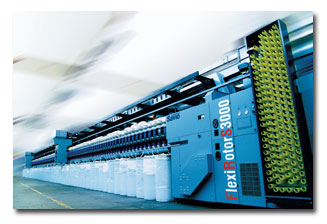
The FlexiRotorS 3000/Duo-Spinner from Savio builds large packages, up to 12 pounds in
weight, which can be fed directly to weaving machines.
CMS 340 TC-M Knit And Wear Machine
H. Stoll GmbH & Co. KG, Germany
The 84-inch working width of Stoll’s CMS 340 TC-M knit and wear machine makes it possible to
produce Stoll-knit and wear® garments in sizes up to triple extra-large. The machine is available
in gauges from E2,5.2 to E7.2, with the option of gauge conversion. Fully Fashion, Stoll-multi
gauges® and intarsia fabrics can be produced using the machine, which combines the advantages of
comb machines with multi-piece knitting for added flexibility and profitability.

Stoll’s CMS 340 TC-M knit and wear flat-bed knitting machine has the widest working width
on the market.
Uniplex™
SSM Schärer Schweiter Mettler AG, Switzerland
Man-made fibers now can be spun into yarns directly from filament fiber, thanks to SSM’s
Uniplex™ spinning machine. Using a stretch break zone, the machine can take low-orientation yarns,
partially oriented yarns or fully oriented yarns and spin them into staple yarn in a single step.
The machine can handle sometimes-difficult-to-process fibers such as microfibers, aramids,
bicomponent fibers and blends of colored man-made yarns.
The six-zone process — pre-tensioning, drawing, stretch break, re-breaking, consolidation
and SSM DIGICONE© preciflex™ take-up unit — is integrated into a single modular machine.
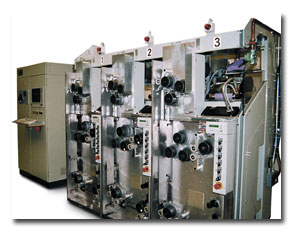
SSM’s Uniplex™ creates spun yarns from filament yarns in a direct one-step
process.
UNIVAL 100 Single-End
Control Jacquard Machines
Stäubli AG, Switzerland
The UNIVAL 100 electronic jacquard machine controls individually each end of a jacquard
harness – from 5,120 ends up to 20,480 ends – using stepping motors called Jactuator®s. The need
for hooks, knives, magnets and pulleys is eliminated because each harness cord or heddle is
attached directly to a Jactuator. Electronic control allows unlimited possibilities for shed
formation and free choice of shed opening and motion for each warp thread or groups of warp
threads. The UNIVAL 100 is driven independently of the actual weaving machine, but is perfectly
synchronized with the loom’s movement. A new JC6 control unit with simple touch-screen operation
controls all programming and machine operation.
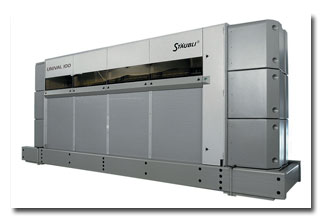
The UNIVAL 100 from Stäubli controls individually each end of a jacquard harness.
Sulzer Textil L9400 Air-Jet Weaving Machine
Sultex Ltd., Switzerland
Sultex’s L9400 air-jet weaving machine represents the company’s latest air-jet technology.
At 213 inches wide, it is the widest air-jet machine manufactured by Sultex. Designed with
technical textiles and carpet backing products in mind, the machine was built to be more sturdy,
durable and economical than its predecessors. Its new air distribution system results in low air
and energy consumption, even at the machine’s top speed of 500 revolutions per minute and a filling
insertion rate of 2,700 meters per minute. The weaving machine features PowerLeno – a patented
device that uses a guide bar and eyeletted reed instead of traditional harness frames and leno
heddles – for shedding and warp twisting. According to the company, PowerLeno subjects the yarn to
low stress levels for faster output and uniform fabric appearance. Maintenance and spare parts
costs are reduced thanks to the elimination of shaft drives and substructure.
TC 03 Card
Trützschler GmbH & Co. KG, Germany
The major design difference between Trützschler’s TC 03 card and conventional cards is that
the cylinder has been raised 1 foot, which increases the potential area available for carding. The
TC 03 card brings a marked increase in productivity and quality with flexibility previously
unavailable in short-staple spinning. Other significant new features include: self-optimization of
waste quality at the licker-in; on-line nep assessment; digital motor controls with
maintenance-free servo motors; precision setting systems controlled by servo motors for the flat
and mote knife; easy accessibility for cleaning and maintenance; and simple color touch-screen
control.
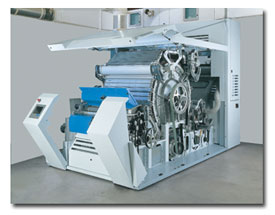
Trützschler’s TC 03 card offers a marked improvement in quality and productivity over
earlier models.
Uster® FABRISCAN ON-LOOM
Uster Technologies AG, Switzerland
The Uster® FABRISCAN ON-LOOM is a contact scanner system used on weaving machines to
automatically inspect fabric as it is woven. The system prevents ongoing production of second-grade
fabric, thus minimizing quality control work later in the production process. According to Uster,
the system is capable of accurately monitoring even very complex weaves and colored patterns. The
system can be programmed to sound an alarm or stop the machine when selected defects are detected,
allowing faults to be corrected immediately.
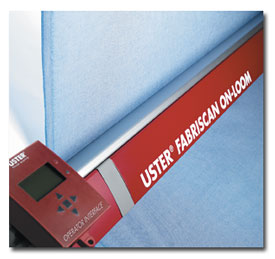
Uster’s FABRISCAN ON-LOOM minimizes quality control efforts downstream by inspecting each
pick as it’s woven.
Universal Cut And Loop UCL83
NV Michel Van de Wiele, Belgium
Using a face-to-face weaving technique, Van de Wiele’s UCL83 three-rapier carpet-weaving
machine is capable of simultaneously creating flatweave effects, cut pile, short loops or long
loops all on one carpet. The patterning flexibility comes from the rapiers, in addition to
profiled lancets and a four-position Multihook jacquard machine. The top and bottom rapiers insert
the filling for the ground structure of the carpet, while the middle rapier inserts a dummy filling
between the lancets, around which loops are formed. During weaving, the dummy filling is removed
and in the case of cut pile styles, a knife cuts the working pile, creating cut-pile sections as it
separates the two carpets.
According to the company, the UCL83 offers productivity rates up to six times higher than
conventional Wilton wire weaving machines.
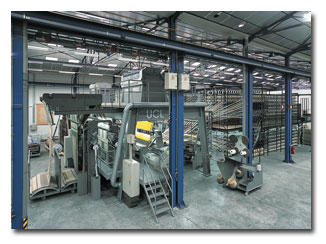
Van de Wiele’s UCL83 machine can create multiple pile heights within the same woven
carpet.
Weave Navigation System
Tsudakoma Corp., Japan
Tsudakoma has used a newly developed algorithm to create the Weave Navigation System (Navi),
which automatically sets and monitors the loom in operation to determine optimal weaving
conditions. The ZAX-Navi expands and enhances automatic setting functions for more detailed and
easier operation.
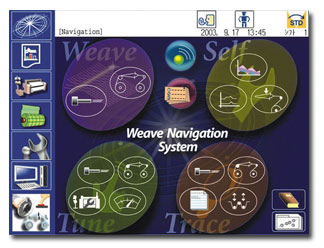
Tsudakoma’s Weave Navigation System automates settings and monitors looms in operation for
optimal weaving conditions.
Once the operator inputs a fabric style into the system, the system determines the necessary
conditions to control weaving. It also recommends mechanical setting values to the operator. The
Self-Navigation system provides self-diagnosis and troubleshooting tips in case of difficulties
during weaving. In addition, the Weave Tips program offers operators advice based on the fabric
being woven.
June 2004




